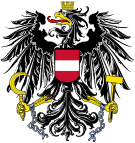
Back Канстытуцыйны суд Аўстрыі Byelorussian Tribunal Constitucional d'Àustria Catalan Verfassungsgerichtshof (Østrig) Danish Verfassungsgerichtshof (Österreich) German Tribunal Constitucional (Austria) Spanish Itävallan perustuslakituomioistuin Finnish Cour constitutionnelle (Autriche) French Mahkamah Konstitusi Austria ID Corte costituzionale (Austria) Italian Forfatningsdomstolen i Østerrike NB
| Constitutional Court | |
|---|---|
| Verfassungsgerichtshof | |
 | |
 | |
| Established | 1920 |
| Location | Innere Stadt, Vienna, Austria |
| Composition method | Justices are sworn in by the President on nomination of either the Government, the National Council, or the Federal Council |
| Authorised by | Federal Constitutional Law |
| Judge term length | Mandatory retirement at 70 years of age |
| Number of positions | 14 members (including the President and the Vice President) 6 substitute members |
| Website | www.vfgh.gv.at |
| President | |
| Currently | Christoph Grabenwarter |
| Since | 19 February 2020 |
| Vice President | |
| Currently | Verena Madner |
| Since | 24 April 2020 |
| This article is part of a series on the |
| Politics of Austria |
|---|
 |

The Constitutional Court (German: Verfassungsgerichtshof [fɛɐˈfasʊŋsɡəˌʁɪçtshoːf] ⓘ or VfGH [faʊʔɛfɡeːˈhaː] ⓘ) in Austria is the tribunal responsible for judicial review.
It verifies the constitutionality of statutes, the legality of ordinances and other secondary legislation, and the constitutionality of decisions of certain other courts. The Court also decides over demarcation conflicts between courts, between courts and the public administration, and between federal and state bodies. It hears election complaints, holds elected officials and political appointees accountable for their conduct in office, and adjudicates on liability claims against Austria and its bureaucracy.
The Court consists of fourteen members and six substitute members, appointed by the president on nomination of the Cabinet, the National Council, and the Federal Council. Although theoretically supposed to, the Court rarely meets in plenum and rarely hears oral arguments; most cases today are decided behind closed doors by panels of either nine or five members. Opinions tend to be concise and academic.
The Constitutional Court is very powerful but has historically exhibited considerable judicial restraint.
Christoph Grabenwarter is currently serving as the court's president.

